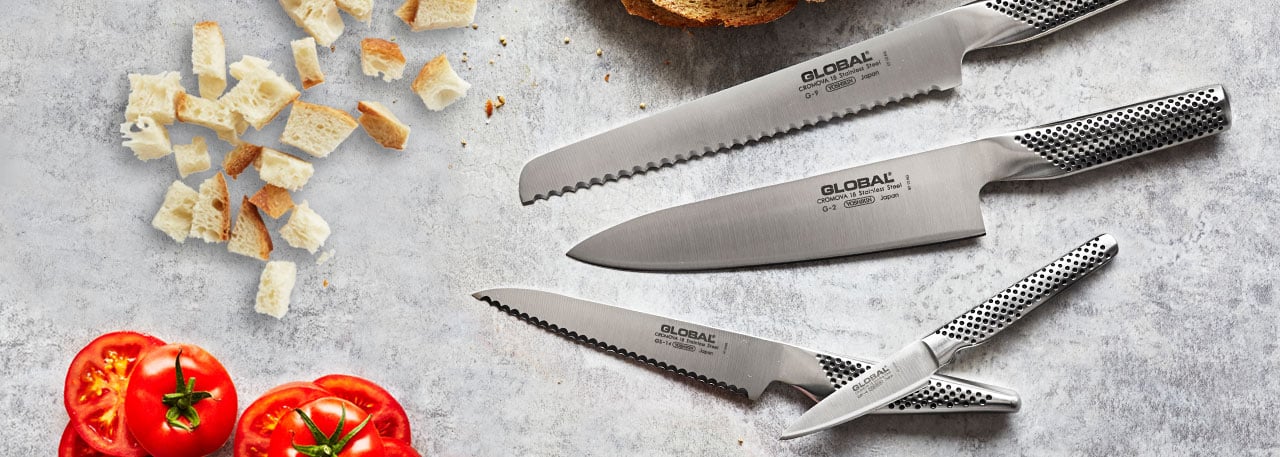Caring for your Global Knives
KNIFE CARE
Looking after your Global knife is very important, as improper care can severely damage your knife. Stamped Global blades have edges that are razor sharp. To obtain such sharp edges, they are factory sharpened at an angle between 10 and 15 degrees. Sharpening at this angle results in a thinner edge, so some words of caution are necessary.
On this page, you will find the information required to care for your knife effectively, including how to sharpen it using the variety of methods recommended, how to clean it correctly and how to store it safely.
 SHARPENING
SHARPENING
Global knives come out of the factory in Japan with a very sharp edge and CROMOVA 18, Globals unique blade material, ensures that this sharpness will be maintained longer than most other knives. However, Global knives need to be sharpened from time to time to maintain their keen edge. As a general rule, the best sharpening tool for an individual is one that he or she is going to use. Each tool is different and maybe easy or difficult to use depending on the individual and their level of experience or skill.
Global recommends periodically sharpening your knives using either a waterstone or ceramic stone. In between stone sharpenings, it is recommended that you use the Global fine ceramic or diamond rod to keep the edges of your knives aligned. (Global serrated knives do not need to be sharpened)
WATERSTONES & CERAMIC STONES
There are various types of waterstones & ceramic stones available and normally a medium grit stone is sufficient to start with. However, if the blade is blunt or damaged, it may be necessary to start with the rough grit. There are several differences between waterstones and ceramic stones. A waterstone must be placed in water and allowed to soak for 10-15 minutes to allow it to absorb sufficient moisture. A ceramic stone also requires water, but only needs to soak in water for 3-5 minutes. A ceramic stone is harder than a waterstone, so it will sharpen your knives more quickly. A ceramic stone will last longer and will not develop valleys or grooves as easily as a waterstone.
Regardless of the size or type of stone, you are using, the procedures for sharpening are as follows:
- The stone should be soaked for the required amount of time before use.
- Hold the knife so that the blade meets the stone at a 10-15 degree angle, then push back and forth across the stone in smooth steady strokes maintaining the same angle. Maintaining the same angle is most important and you will know that you are maintaining the same angle from the sound the knife makes against the stone. If you are making the same sound with each stroke back and forth against the stone, you are maintaining the same angle.
- Repeat the stage above on both sides of the blade going from one side to the other until your knife is sharp and there are no burrs on either side.
- During sharpening a certain amount of wet powder will appear, but do not wash or wipe this residue and continue sharpening. Although this powder appears unsightly, it is this residue which sharpens the knives.
- After sharpening, your knives should be washed in hot water and then towel dried.
NOTE: Achieving the correct angle is sometimes difficult, particular for beginners. Most Global stockists will carry a product called "MinoSharp Sharpening Guide Rails" which help to achieve the correct angle when using waterstones and ceramic stones.
WASHING & CLEANING
It is recommended that you wash your Global knives by hand using a mild dishwashing liquid and water. After washing, rinse with water and dry thoroughly with a towel. Global knives should NOT be put in the dishwasher. Doing so could damage the sharp edges should they come into contact with other objects in the dishwasher. In addition, exposure to extreme heat and powerful detergents found in dishwashers can be harmful to CROMOVA 18 high carbon stainless steel.
If your knife is not stored or cleaned correctly, you may find that rust can start to develop on it. General household stainless steel cleaners are available on the market, and any of these can be used to remove rust from your stainless steel. Alternatively, Global also has a magic rubber, which can remove small rust spots.
STORAGE
Global knives are very sharp and should be carefully stored to avoid accidents and kept out of the reach of small children. Global recommends the use of the Global knife blocks, magnetic wall racks, knife docks, blade guards or knife rolls/cases. A variety of different solutions are offered by Global to help keep your knives safe and in good condition.
CAUTION
- Do not cut with a chopping (up and down) motion. This is not the proper way to cut and only dulls your knife. Cut with a slicing (forward and backwards) motion.
- Do not soak before cleaning. In particular, avoid soaking in harsh cleaning solutions and any solution containing bleach.
- Do not use harsh detergents or cleansers containing chlorine bleach.
- Do not use these knives for any purpose other than for what they were intended, i.e. the preparation of food. Under no circumstances should they be used as a screwdriver, crowbar or wirecutter.
- Do not cut on a marble, stone, tile or glass surface.
- Do not attempt to cut through frozen foods or bones. If you should slice into something frozen or solid, remove carefully using a slicing (forward and backwards) motion. DO NOT twist the knife side to side to remove it. Doing so will bend your edge and possibly chip it leaving a chunk of the knife in the solid matter.







